Sanded Iron Skillet Heated Looks Red Again
Bandage-fe skillets, griddles, and Dutch ovens are versatile and durable. But over time, they can become sticky and hard to cook in as a layer of carbon and hardened food residue builds up, sometimes concealing a layer of rust firmly anchored to the cast iron beneath. That terminal point is important. Bandage fe is a reactive metal, and water introduced in cooking and cleaning volition attach to the iron. The rust is rough and porous; information technology forms an attractive surface for nutrient remainder and hardened oil. The result is cookware that'south a nuisance to work with.
Fortunately, the set is elementary. Sand off the crust and flavor the pan with loftier-temperature cooking oil. In doing so, you'll convert the sticky, crusty surface to one that is cute, sleeky, and nonstick.
Seasoning is nada more than producing a broiled-on layer of polymerized cooking oil on the pan's surface. According to cookbook writer and our grill consultant, Dave Joachim, seasoning is simple: Utilise a thin layer of oil and oestrus it higher up its smoke signal (unremarkably between 350 and 450 degrees) for up to an hour to vaporize lighter hydrocarbons. This leaves heavier molecules to form a polymer (really, a unproblematic form of plastic) on the iron. Season a pan every time after you cook.
It'southward important to draw a distinction betwixt routine seasoning and the multistep restoration process that nosotros prove hither. I used the four easy-to-follow steps shown below to sand clean and season two pans from Lodge Cast Iron: a threescore-year-former skillet I inherited from my mom and a 14-year-sometime griddle. Both needed a seasoning overhaul.
Earlier you get started, you'll need to gather upwardly (or purchase) a few essential items. If you lot're missing something on this list, check out our four recommendations below to assistance you fill in the gaps.
What Y'all'll Need
• An one-time towel or nonslip condom mat, a clean fabric or kitchen towel, lint-free cloths
• Safety glasses, dust mask, paw cleaner, leather gloves
• A random-orbit sander
• eighty-, 100-, and 120-dust sandpaper discs (sixty, as well, if your pan is likewise far gone)
• High-heat seasoning oil, such as flaxseed
Footstep 1: Sand
Launder the pan with water and dish detergent, and dry information technology to remove the sparse film of surface grease. Identify the pan on an old towel or nonslip safety mat. With a random-orbit sander, brand thorough passes over the surface using 80-, 100-, and 120-grit sandpaper discs. (Note: If the pan is rusty or has severe black scale on its surface, you may demand to commencement with threescore-dust.) Sand thoroughly with each grit, offset with the lowest-number (or coarsest) grit and working upward. Information technology will probably require more than one disc of each dust to complete the sanding at that level earlier moving to the next.
Tip: Sanding cast atomic number 26 is muddied work. Wear prophylactic glasses, a dust mask, and old wear. Clean the work area thoroughly when you are done and vacuum the sander clean. You'll demand hand cleaner to get the carbon and rust off your easily. Put your work vesture into the wash immediately.
Step 2: Prepare
Preheat the oven to a temperature equal to the smoke point of the oil yous are using, which is typically in the range of 350 to 450 degrees. While the oven is warming upwards, prepare the pan. Remove metal particles and carbon dust. Thoroughly wipe it down inside and out with a clean, lint-free cloth, soaked with the same oil you volition use for seasoning (flaxseed oil is a skilful choice). Rinse the pan, dry it, then place it on a stove-meridian burner on medium-loftier heat, and bring it up to seasoning temperature. How long that will take depends on the burner'southward BTU output and the size of the pan. A large and deep skillet may take xv or twenty minutes to heat; a small griddle may take 10 minutes.
Tip: The oil'south fume signal may exist listed on the bottle's label. If not, a simple Google search should get you the answer you demand. Flaxseed oil, for case, has a fume bespeak of 450 degrees.
Stride 3: Seasoning on the Stove Tiptop and in the Oven
Rotate the pan on the stove summit as it heats to ensure information technology's evenly heated. When the pan is hot, simply not smoking hot, pour about a teaspoon of the high-temperature seasoning oil into the pan and carefully spread information technology over the pan'due south inner surface, rim, and its outside—which should also be nonstick. Wipe with a clean, lint-free fabric. Plough the burner off. Wipe the pan dry with a separate clean cloth until there is no more than than a faint sheen of oil.
While the pan is however hot, place it in the preheated oven—top side up—and leave it at that place for an hour. Later an hour, turn the estrus off and permit the oven and pan cool to room temperature earlier removing the pan (about some other 60 minutes or and then).
Echo this entire process of stove-top seasoning followed by oven seasoning as many times as necessary to produce a sleeky, nonstick surface. It will probably require at least three or 4 trips over the stove top and into the oven before you're done (each trip over the burner and into the oven counts as 1 seasoning pass). It's a proficient idea to alternate the pan's position—top side up the beginning trip, lesser side up the next—every trip into the oven. Switch to top side up on the third pass and then bottom side up for the quaternary pass. This ensures uniformly seasoned cookware with a nonstick surface on its inside and exterior.
Tip: Wear leather gloves when wiping out a hot pan. It'southward easy to give yourself a burn, especially on deep pans when you wipe the rim. Also, if your oven's temperature is above the oil'south smoke point, the oestrus volition produce carbon, blackening the pan. Some purists insist on producing a glossy black stop and theorize that the formation of carbon produces a tougher seasoned surface. Nosotros stopped the seasoning procedure after four trips over and through the oven, producing dark grayness-bronze pans in the procedure. Neither is glossy black. The pans melt like a champ and we'll let them blacken over time.
Step iv: Set up to Cook
This might be overly cautious, only after putting all that piece of work into the overhaul process, I make certain to apply a layer of high-temperature oil to the pan's inside the start time I cook with it. I heat the pan to cooking temperature, give the inside a light blanket of oil, thoroughly wipe off whatever excess, and brainstorm cooking with whatever oil or fat the recipe calls for (olive oil, butter, bacon fat). Overkill? Possibly. I oasis't constitute information technology necessary to do this every fourth dimension I melt. If annihilation, cooking and routine seasoning improve the pan's performance.
Immediately after cooking, plow off the burner, wipe the pan out, pour in some hot water, and let information technology steam while yous consume. After the meal, pour out the water and gently remove any slightly stuck-on food. At this signal, the pan is clean but non reseasoned. Reheat the pan, pour in a little high-temperature cooking oil, then advisedly wipe off excess oil, leaving it with a slight sheen. Let the pan heat for a few minutes before turning off the estrus, and wait for the cookware to cool earlier storing it.
Tip: After wiping the pan and rinsing information technology, I besides like to pour hot water in it to steam clean it (I simply heat a Pyrex container of water in the microwave). Don't utilize common cold water, co-ordinate to many cast-iron experts; the thermal shock might crevice it.
This content is created and maintained by a tertiary party, and imported onto this page to help users provide their email addresses. Y'all may be able to find more information about this and like content at pianoforte.io
Source: https://www.popularmechanics.com/home/a35839585/cast-iron-seasoning/

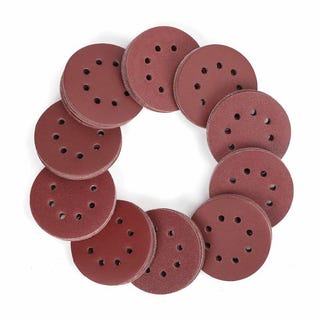


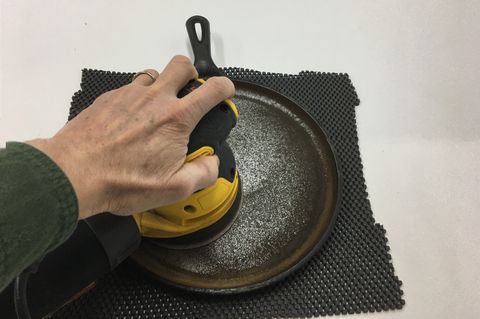


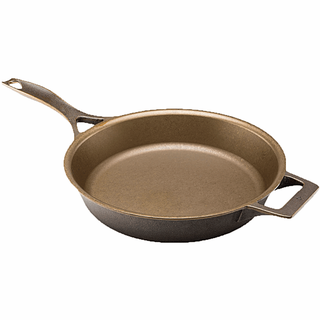
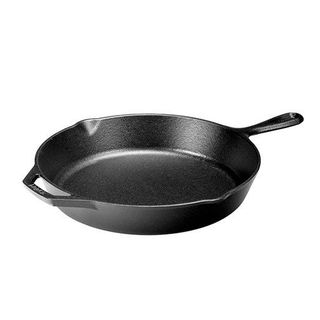

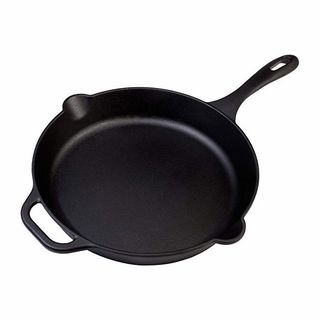
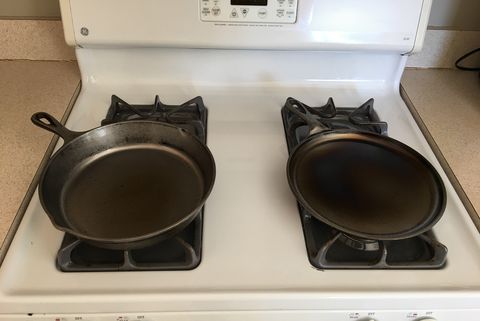
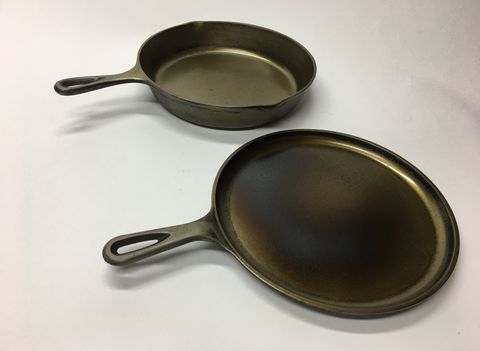
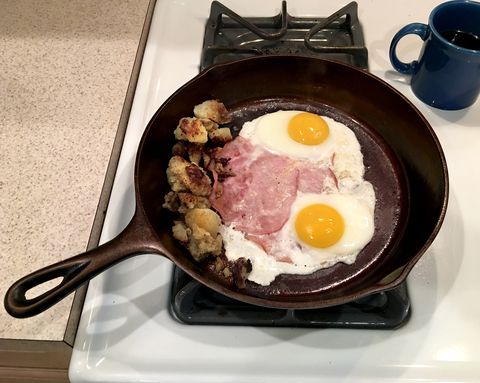
0 Response to "Sanded Iron Skillet Heated Looks Red Again"
Post a Comment